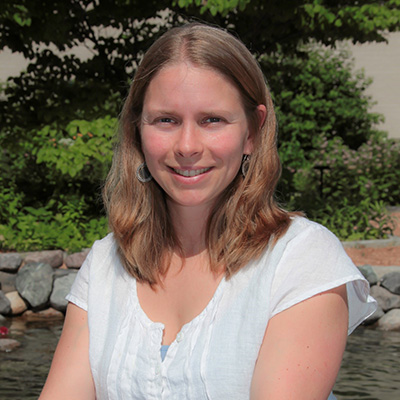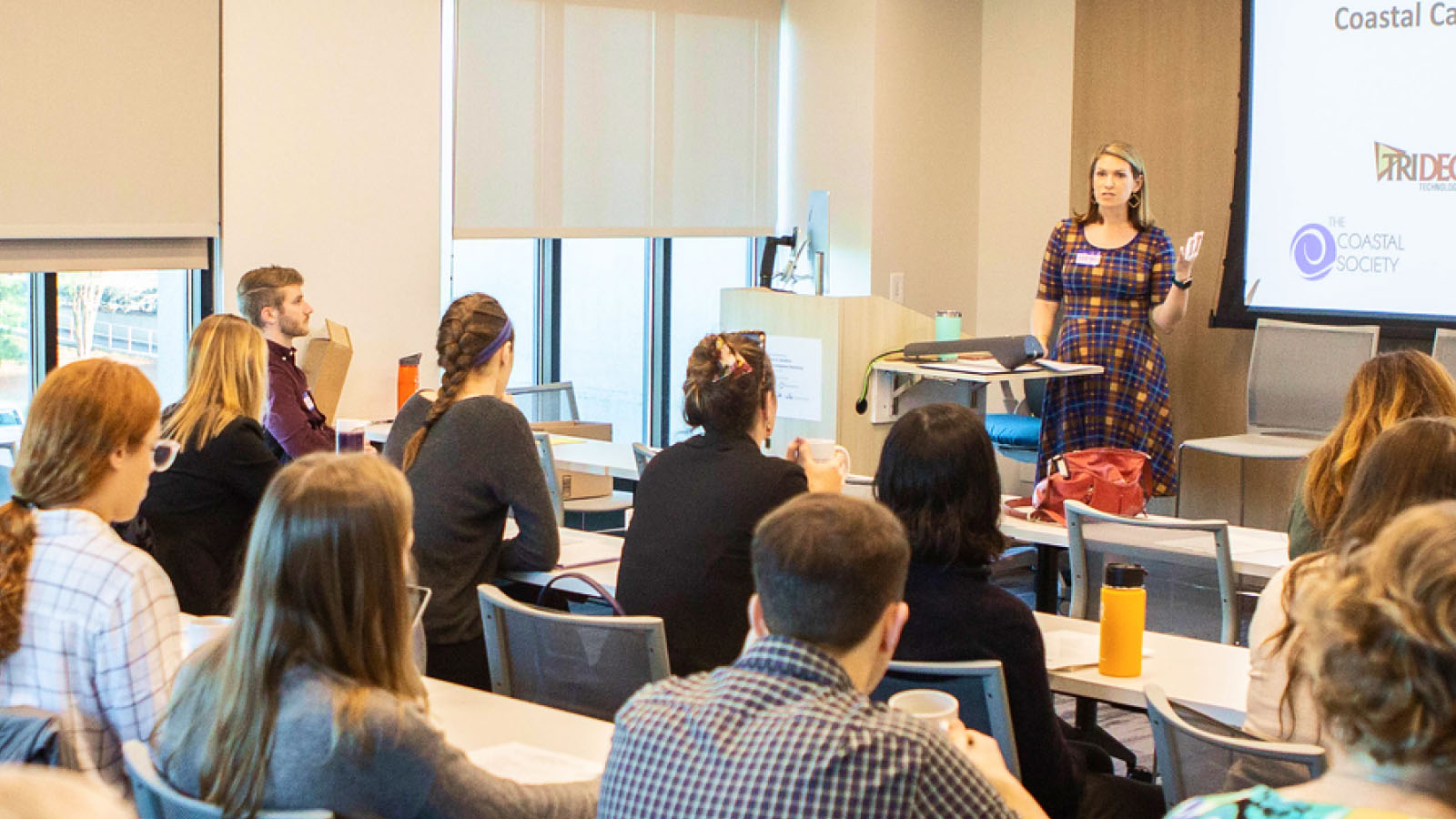The Takeaway: Learn how a Sea Grant agent is working with one community to audit and amend its existing land use codes and ordinances to be more inclusive of green infrastructure projects.
Overview
A major barrier to implementing green infrastructure is existing municipal codes and ordinances, which may not allow for—or be flexible about—green infrastructure practices. To help municipalities identify opportunities for code amendments, Wisconsin Sea Grant’s Julia Noordyk and her team developed the Tackling Barriers to Green Infrastructure: An Audit of Local Codes and Ordinances workbook, along with an accompanying community engagement process. Learn how they used it with a small coastal Wisconsin community to help build their resilience to coastal hazards.

Lessons Learned
- Be prepared to hand-hold. People need a push to do these types of activities. Their hearts are in it, but they have other responsibilities that take priority. In this case, it was helpful to have a land use planner review the codes and identify opportunities along the way.
- Ensure that efforts to promote green infrastructure are not lost. Since the future is uncertain in terms of elected leadership and municipal staff, the community should make sure the recommendations are codified so that no matter who is leading the charge, green infrastructure implementation can continue.
- Pilots provide learning opportunities. Having a pilot helps coordinators like Julia learn more about the process of working with communities to audit their codes and ordinances for barriers to green infrastructure. For this project, it was also an important step in testing the workbook and getting feedback. Julia points out, “Kate and Juli Beth were invaluable in guiding me through the process, and I owe them a lot for allowing me to expand upon their work.”
- Get a code expert on your team. It’s critical to have someone who understands (and enjoys) codes and ordinances.
- You won’t convince communities to do this. They have to be ready and willing. Julia’s role was to help this municipality move forward with its goals, and to work with other Sea Grants to help communities in their states.
- Implementation is a work in progress. There are many barriers to green infrastructure, with codes and ordinances being only one of them. Some people don’t believe green infrastructure is the right option, or have concerns about operations and maintenance. Some communities have aesthetic or cultural preferences that they think are at odds with green infrastructure. There are also many misperceptions, including about permeable pavements working in cold climates or for certain soil types.
- Don’t be prescriptive on which approach to use. Refer to technical design standards if they exist, but since green infrastructure technology is rapidly evolving, allow for flexibility in the particular approaches people can use.
The Process
If a municipality’s land use code language does not clearly state that green infrastructure is an acceptable or preferred approach to managing stormwater, it will likely not be considered in development proposals, design plans, or capital projects—even if some community members are interested in it.
Realizing this, Julia Noordyk, water quality and coastal communities outreach specialist with Wisconsin Sea Grant, is working with communities to assess their current codes and ordinances. She is helping them determine if these codes allow for green infrastructure as a means of reducing flooding, improving water quality, and adding aesthetic appeal. Julia is using the workbook she created, Tackling Barriers to Green Infrastructure: An Audit of Local Codes and Ordinances, as a starting point for confronting regulatory obstacles. It helps communities review and prioritize their codes and ordinances in the context of improving stormwater runoff mitigation through the reduction of impervious surfaces and enabling green infrastructure implementation.
The workbook describes a community-oriented engagement approach to identifying the individual needs of the community. Additionally, it provides a detailed auditing tool, highlights common key challenges, and recommends next steps.
To test the workbook and community engagement process, Julia has been piloting it with the city of Port Washington, Wisconsin. Through an existing relationship with Wisconsin Sea Grant and the Coastal Storms Program, Julia learned that Port Washington was eager to increase their its resilience, and wanted to use green infrastructure as a tool to help them achieve this.
Initially, Julia told community leaders that she had just completed a final draft of the green infrastructure audit, and asked if they would be interested in working through it to identify opportunities for code amendments. “The mayor was supportive of this project since day one, and participated in all of our meetings,” Julia says. “He offered a ton of local knowledge and saw the benefits of using green infrastructure as a resilience tool.”
Julia’s role in the project was to coordinate the work, engage the community, build a team of experts, and keep it moving. Working alongside Julia were Juli Beth Hinds, a land use planner and the creator of the audit tool, and Kate Morgan, a community engagement specialist. Port Washington’s mayor, public works director, and planning director each participated in the audit.
“I’m not a land use planner or a stormwater engineer, so it’s been great having Juli Beth, from Orion Planning + Design, help guide the community through their codes and ordinances audit and make recommendations for revisions,” says Julia. “I also appreciate Kate Morgan’s experience in using the methodology with other Wisconsin communities and helping key in on engagement strategies with Port Washington. I highly recommend having someone on the team who can speak at the local planning level.”
Port Washington’s Code and Ordinance Audit
Julia conducted the process within three meetings.
- The first meeting focused on the team getting to know each other, discussing the scope of the project, and agreeing to provide feedback to Julia on the experience. The team also talked about Port Washington’s goals for auditing its codes: making the community more resilient to coastal hazards and having green infrastructure be part of the solution.
The municipality’s first task was to fill out the community scoping worksheet, which asks questions about community planning, community identity, hazards, stormwater regulations, natural assets, and current green infrastructure usage. This helps uncover any concerns or objections that the community might have to green infrastructure, and helps to identify potential allies for adopting code changes that favor these practices.
- During the second meeting, Julia and her team met with the municipal staff to discuss the town’s responses to the community scoping questions. Julia noted that in addition to the comments by the planning and public works directors, having the mayor in this meeting added helpful details and information.
Overall, the community scoping exercise revealed that the city was open to green infrastructure, but was not moving ahead as much it could be. They discussed several areas of opportunity for implementing green infrastructure and identified potential supporters, including the Port Washington Environmental Planning Committee, Ozaukee County Land Trust, and the Treasures of Oz, a partnership of organizations and individuals who work together to promote environmental awareness, education, and stewardship in the county.
The city’s next step was to use the workbook’s audit tool to review and grade itself on its codes and ordinances. Each worksheet addresses a key code and ordinance topic area where green infrastructure and impervious surfacing barriers are found. The tool provides a grading matrix to indicate whether a code, policy, or operation is enabling, conditional, ambiguous, discouraging, or conflicting with green infrastructure. Example questions in the worksheet include, “Are green infrastructure practices suitable for high-density areas (e.g., planter boxes, cisterns) allowed to extend into the right-of-way or onto sidewalks?” and “Has green infrastructure education been provided to planning boards and elected officials?”
- When it was time for the third meeting, the goal was to review the city’s audit. However, the town didn’t get as far as it had hoped with the audit. Luckily, Juli Beth came prepared. She reviewed the city’s codes and offered recommendations on which audit topic areas to focus on, as well as where amendments were needed.
“Although Port Washington really wants to increase their resilience and is keen on going through this process, we have three very busy people on the team, all with day jobs,” Julia notes. “Finding the time to do the audit was somewhat of a barrier for them. We’ve had to do more hand-holding than anticipated, but I don’t think that’s a bad thing. It’s why we are here.”
One of Juli Beth’s recommendations, which is one she often makes, was related to the city’s landscaping standards; she pointed out that they were very prescriptive. This, according to Juli Beth, is a major “missed opportunity.” Juli Beth wanted to get them thinking about how the standards could be amended to allow for, and encourage the use of, green infrastructure-friendly landscaping. Too often, landscaping is an afterthought in development projects, but if brought in as a stormwater management tool, it can have significant payoffs in terms of reducing stormwater and pollution.
Next Steps
Julia is continuing to work with Port Washington to complete its audit, after which Juli Beth will be able to recommend specific code revisions and amendments. The city and project team will meet one last time to talk about the audit process and discuss which priorities to move forward on. The goal is that the recommendations will end up in front of the city council for approval and adoption.
Julia is extremely excited about getting the word out about this valuable tool and spent several months on the conference circuit to build awareness. “I get about two requests per week from people across the country who are eager to learn more about the audit,” she says. The reason she believes this has garnered so much attention is that it is based on concrete, identified needs: “We did our homework by asking communities what products they wanted. We conducted a needs assessment a few years ago, and the top two needs were flood maps and help with code and ordinance assessments.”
Helping Her Peers
Julia is working within her Sea Grant network to share her experience, testing it out with communities so that others can understand what the tool offers and how to use it. She’s always happy to answer questions and share what she knows.
Julia is also working with Minnesota Sea Grant to share her process and lessons learned. A workshop was held to discuss flooding issues, green infrastructure options and benefits, and why codes and ordinances are barriers to using green infrastructure. The participating communities used the scoping worksheet and audit tool.
